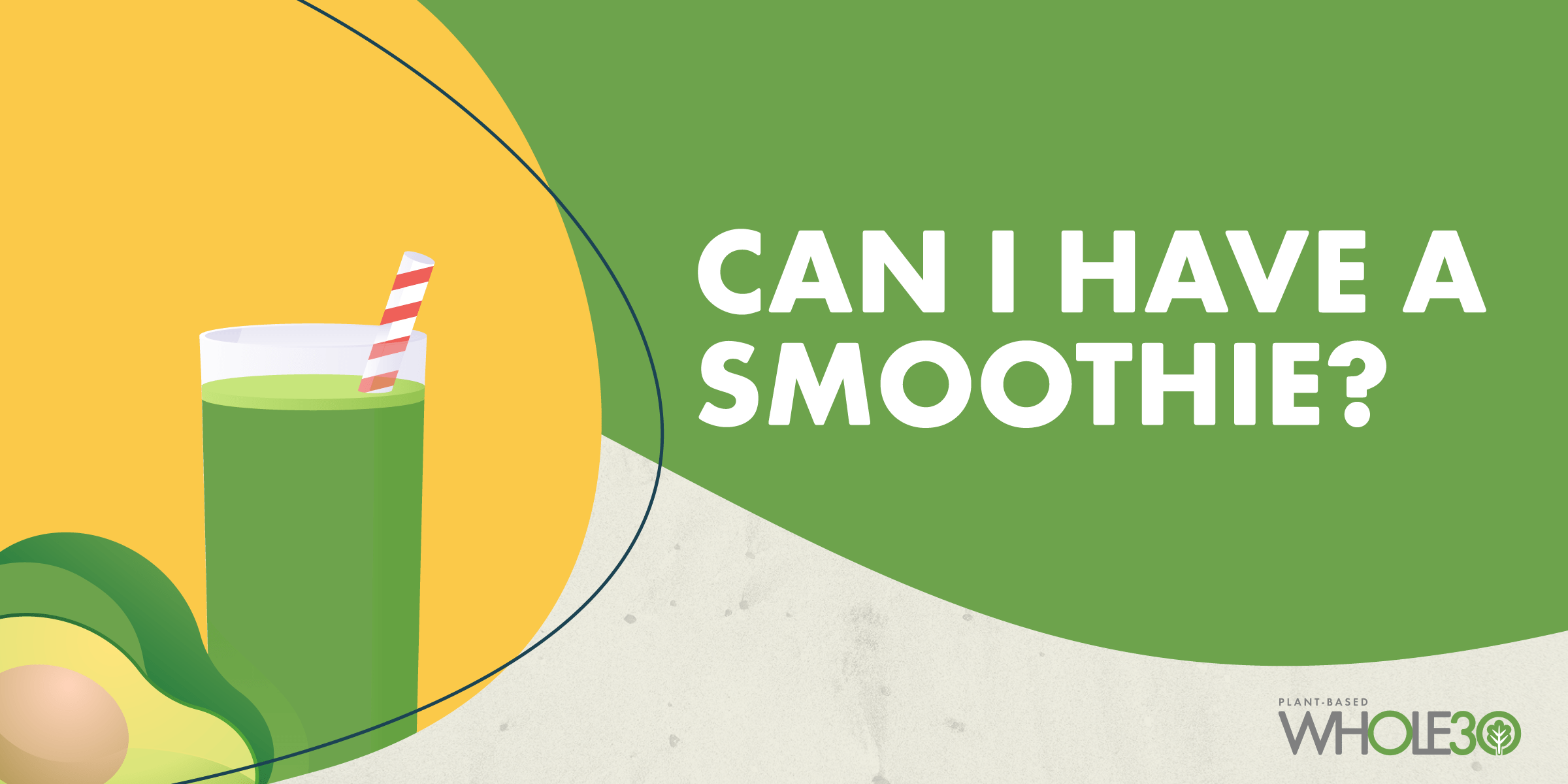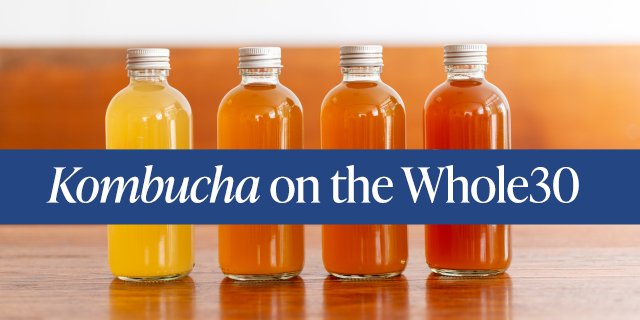Smoothies: A delicious, thick, creamy beverage that can be used as a quick option on busy mornings, a way to sneak in more fruits and veggies, or a midday snack to see you through until dinner. But are they a good option for your Plant-Based Whole30?
If you’ve been part of our community for a while, you probably already know our stance on smoothies for the Original Whole30 program. While smoothies made from Whole30 compatible ingredients have always been allowed, we generally caution people against fruit-heavy smoothies used as meal replacements. While they can be helpful in some contexts, like for pregnant or nursing people or those recovering from an illness, we’ve always encouraged you to think about why you’re using a smoothie, and if they truly serve your Whole30 goals compared to a hearty, protein-rich breakfast that you chew.
However, smoothies may play a bigger role in your Plant-Based Whole30, specifically as a means to help you get adequate protein in a way that is digestively-friendly. Here’s why:
Smoothies and the Plant-Based Whole30
Protein on the Plant-Based Whole30 comes primarily from soy products like tofu or tempeh and legumes like beans and lentils, with a smaller boost from nuts and seeds. However, legumes can be hard to digest, especially for those new to a plant-based approach. Eating legumes or lentils often may not work for every Plant-Based Whole30’er, and that could leave some falling behind in daily protein requirements.
Smoothies made with unsweetened plant-based protein powder (like Sprout Living Epic Protein Powder or Nutiva Hemp Protein Powder) are recommended on the Plant-Based Whole30 as a protein option for those who have a hard time digesting legumes and lentils for multiple meals, or for those with higher protein needs (like athletes). This option allows individuals to ensure sufficient protein in a form that’s easier on their stomach, especially if they are new to a plant-based diet. This also gives an individual’s microbiome a chance to adapt to the higher fiber content of legumes and lentils, allowing them to introduce those foods more gradually as their Plant-Based Whole30 progresses.
However, not all smoothies are created the same. Whole30 guidance states that compatible smoothies should be lower in sugar and not resemble a dessert; should contain adequate protein, fiber, and fat; and should be consumed as part of a meal, not as a meal replacement. Let’s break that down further.
Smoothies: Is it dessert-y?
There are many different ways to build a smoothie, but not all formats are the best choice on a Plant-Based Whole30. Our first consideration is the amount of sugar and other “dessert-like” flavors present. Remember, the Whole30 is designed to help you reset your health, habits, and relationship with food. Calling “breakfast” a fruit-heavy smoothie with dates and nut butter (or eating that same smoothie late at night to satisfy a sugar craving) probably isn’t serving those goals, and that’s something we want you to take personal responsibility for on your Whole30.
Technically, the smoothie described above, loaded with fruit, dates, and unsweetened nut butter, could be compatible with the program rules. Technically, if you drank one of these every morning for breakfast, you’d still be doing the Plant-Based Whole30. But it’s likely that smoothie also comes with sugar cravings, hunger a short hour later, and volatile energy levels. Review our Pancake Rule again, and ask yourself–do you really want to come out of your reset with the same sugar cravings, relationship with food, and habits that you had going into the program?
There is both physical and emotional work involved in doing the Whole30, and the rules are just the beginning. You’re not only resetting your health, you’re also resetting your habits and your relationship with food. Exploring your relationship with cravings, emotional attachments to foods, and your habits will lead to huge non-scale victories (NSV), helping you do deeper work on why you may be turning to sweet options and learning to make choices that actually serve you better.
Smoothies: Is it well-balanced with protein and fat?
One often overlooked aspect of building a smoothie is its macronutrient balance. A smoothie made with just blended fruit and liquid will have a much different physiological response than one made with plant-based protein, healthy fat, and fiber.
If the intention of a smoothie is to serve as a mini-meal to see you through until lunch or dinner or a way to add extra substance to your meal, you want that smoothie to be satiating. A smoothie that includes protein and fat is a far better option than one loaded with fruit and low in protein and fat.
Are you often hungry within an hour or two after you consume a smoothie? Does your blood sugar crash, leaving you cranky and brain foggy? That could be because the protein was carb-heavy with lots of fruits, dates, and minimal fat and protein. Use our template below to create a balanced smoothie that should keep you fuller longer.
Liquids (8-12 fluid oz):
- Unsweetened Whole30 Approved nut milk, such as New Barn, MALK, or JOI
- Filtered water
- Canned coconut milk (which also adds healthy fat!)
- Brewed tea
Protein (15 grams of protein, minimum):
- A Whole30 Approved plant-based protein powder (such as Sprout Living Simple Protein and Epic Protein and Nutiva Hemp)
- Silken tofu provides the best texture, but extra or super firm provides the most protein
Fat (1 serving, minimum):
- Avocado
- Seeds (chia, hemp, pumpkin, ground flaxseed, etc.)
- Unsweetened nut butter, seed butter, or coconut butter
- Unsweetened coconut flakes
Fruit (½ to 1 cup):
- Berries, your best option for a lower-sugar smoothie (up to 1 cup)
- Apple, pear, or peach (fresh or frozen, up to 1 cup)
- Pineapple or mango (up to ½ cup)
- Unsweetened acai puree (up to ½ cup)
- Banana (1 small banana; frozen provides a creamy texture)
Veggies (1 cup, minimum):
- Leafy greens
- Mashed pumpkin
- Mashed butternut squash
- Mashed sweet potato
- Cauliflower rice
- Zucchini
Smoothies: With a meal, not instead of
Another reason smoothies don’t tide you over for very long is because the food that you drink sends different satiety signals to your brain than foods that you chew. Studies show that drinking meals, even if it is well-balanced in terms of macronutrients, may not be as satisfying or keep you full as long as chewing and swallowing an actual meal.
Our best practice smoothie recommendations include making one as part of your meal, such that it’s not a meal replacement, whenever possible. This is a great way to get extra protein into your diet, especially if you have higher protein needs, without feeling like you need to eat again an hour later. An example would be a smoothie with compatible plant-based protein, almond milk, leafy greens, and a cup of berries, paired with sauteed mixed veggies with tahini dressing and a side of avocado for breakfast.
However, smoothies can be a good stand-alone choice as emergency food if you’re on the go, or a mini-meal if you need a little something to see you through to lunch or dinner. Even though these aren’t designed to take the place of a meal, make sure you include enough protein and fat to truly tide you over.
How smoothies CAN work for the Plant-Based Whole30
During the Plant-Based Whole30, smoothies are a great option when:
- You’re new to a plant-based diet and having a hard time digesting legumes and lentils.
- You’re dealing with a temporary sickness (cold, flu, food poisoning) and need something easy to digest.
- You have higher protein needs, and need extra protein in an easily-digestible format to compliment meals.
- You’re trying to increase calories in your plant-based diet, but feel too full for an additional plated meal.
- You want a lighter breakfast that doesn’t include legumes or lentils.
However, if you find that even following these recommendations, smoothies trigger your sugar cravings, leave you feeling less satisfied than a plated meal, or you just don’t like the taste or texture of unsweetened plant-based protein powders, leave them out of your Plant-Based Whole30. It’s just as easy to do a Plant-Based Whole30 without smoothies, and if they don’t work for you, you have many other delicious ways to get your protein in.
Check out our Plant-Based Whole30 Prep Pack, featuring 3 exclusive recipes, the Plant-Based Whole30 Rules, and other helpful resources to help you maximize Whole30 success.
















